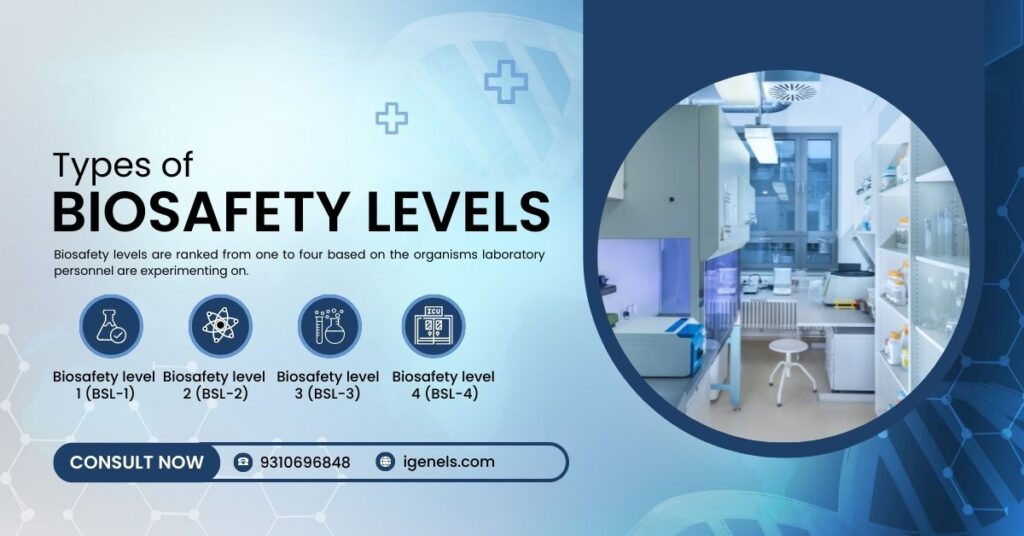Researchers have to focus on safety levels while working with autoclaving equipment in a laboratory setting. To ensure the safety of scientists and lab technicians, the regulatory bodies have defined biosafety cabinet levels—each with particular safety protocols—for various types of facilities. Biological Safety Levels (BSL) can be referred to as a series of protections pertaining to autoclave-related activities that take place in biological labs. Biosafety levels are ranked from one to four based on the organisms laboratory personnel are experimenting on.
How are biosafety levels defined?
The purpose of setting biosafety levels is to indicate what particular measures a laboratory must have in place for the containment of biological agents and microbes. Each biosafety level is defined according to the following factors:
- Risks associated with containment
- Transmissibility
- Severity of infection
- Origin of the microbe
- Type of the work conducted in the lab
- Route of exposure
- Agent in question
Types of biosafety levels
Given below are the 4 types of biosafety cabinet levels:
- Biosafety level 1 (BSL-1): Considered to be the lowest of the four biosafety levels, BSL-1 applies to laboratory settings in which researchers work with low-risk contaminants that have little to no threat of infection in adults. For instance, a BSL-1 laboratory may work with a nonpathogenic strain of E. coli. These labs conduct research on benches, and hence, don’t use any kind of special containment equipment. Safety protocols for BSL-1 labs include mechanical pipetting, regular handwashing, safe sharps handling, biohazard signs, etc.
- Biosafety level 2 (BSL-2): BSL-2 covers laboratories that work with agents related to human diseases. More often, these agents come in the form of infectious or pathogenic organisms that pose a moderate health hazard. Such agents include equine encephalitis viruses, staphylococcus aureus, and HIV. These biosafety cabinet labs adhere to the standard microbial practices as BSL-1 labs coupled with enhanced measures owing to the potential risks associated with these microbes. Researchers working in BSL-2 labs are expected to take extra precautions to prevent injuries like cuts, bruises, and other skin breakages. The safety protocols established for BSL-2 labs include the use of PPE, self-closing doors, and access to a sink. However, access to a BSL-2 lab is more restrictive than a BSL-1 lab.
- Biosafety level 3 (BSL-3): A BSL-3 lab works on indigenous microbes that can cause serious disease through inhalation. In BSL-3 labs, common examples of microbes include the West Nile virus, yellow fever, and tuberculosis bacteria. Contaminants found with BSL-3 settings are strictly controlled through regulatory bodies. Here, the researchers are also under medical surveillance and may require immunizations to combat the impact of microbes. The safety control measures within a BSL-3 lab include the use of PPE, solid-front wraparound gowns, and scrub suits, access to an eyewash station, sustained directional airflow, and a self-closing set of locking doors.
- Biosafety level 4 (BSL-4): BSL-4 labs are rare as they work with exotic and highly dangerous microbes like Marburg and Ebola viruses. These microbes create fatal infections and come without treatment. The safety protocols to be followed in BSL-4 labs include decontamination of materials and wearing the PPE from lower BSL levels apart from level 3 considerations. It’s one of the reasons why these labs are isolated and located in a separate building entirely. These biosafety cabinet labs also feature a supply of exhaust air, as well as decontamination systems and vacuum lines.
A biosafety level is a set of biocontainment precautions required to isolate hazardous biological agents in a closed laboratory facility. Before working with microbes in a lab setting, you need to know the difference between corresponding safety requirements and biosafety levels.

